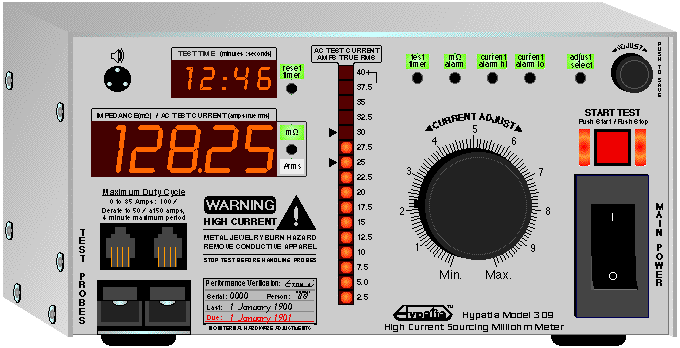
Audio Annunciator: Sounds whenever
an alarm condition occurs. Clicks for other functions (if selected in preferences).
Test Time Readout: Between tests, indicates
the program test time. During a test, reads as an automatic count down timer
indicating the test time remaining in minutes and seconds. When zero is
reached the test is automatically terminated and the timer automatically
resets, ready for the next test. The manual reset button allows you to set
the timer back to the program test time without interrupting a test (not
normally required).
Impedance or Test Current Readout: 5 Digit
display of impedance in milliohms to 100 ohms or true rms test current,
selected by the meter mode button to the right. The active mode is lighted.
Current measurement range is 144 Amps, but note operating limits.
Test Current Dot or Bar Graph: Continuous
indication of true rms test current in 2.5 amp increments. The last window
stays lighted for currents above 40 amps, then the scale continues from
the bottom. Range is 77.5 Amps - note operating limits.
Function Controls: Test timer, milliohm
alarm, current alarm high and current alarm low. Press to activate, press
again to deactivate. Lighted when active. The associated function light
blinks rapidly to indicate a specific alarm condition, and blinks slowly
when in the adjust mode (see control settings).
Control Settings: It's easy to precisely
adjust control settings. Select the control by pushing the adjust select
button until the desired control is blinking or indicated. Rotate the adjust
knob (a rotary actuator) until the desired setting is reached as indicated
on the associated display. Push the adjust knob to save your setting into
nonvolatile flash memory. Controls with settings include test time, milliohm
alarm, current alarm high, and current alarm low. Enter the user preferences
mode by holding the adjust select button down during power up. Then adjust
preferences in the same manner as before. User preferences include current
graph mode (dot or bar), readout resolution, readout brightness, network
modes, key click audio and others.
Test Current Adjust: Full range, continuously
adjustable test current control. Normally set to provide a test current
of 25 or 30 amps depending upon certification testing requirements. A variance
in the impedance of the unit under test can alter the test current, but
for repetitive tests of identical products the variance isn't normally significant.
Start Test Button: Press momentarily to
start or stop a test. Dynamic lighting during a test. Automatically turns
off when a timed test is complete.
Main Power and Overload Protector: Switch
on to turn on the instrument (does not initiate a test cycle). Both line
and neutral power conductors are monitored for overloads. This control physically
switches off under overload conditions, disconnecting both line and neutral
conductors for safety.
Probe Connections: Plug any Model 100
series probe into the left connector pair, and any other Model 100 series
probe into the right connector pair. A probe's power and sense connectors
should be on the same side (don't cross the sense lines). All probes incorporate
built in remote voltage sensing at the probe heads, thus providing accurate
measurements without resistive or temperature coefficient offset errors.
For the highest precision or multipoint measurements within a single test,
the independent Model 109 Kelvin sensing probes may be used with any other
100 series probe set. Connections are fully floating with respect to ground,
but some network modes connect the left probe to network common - note limitations
in the owner's manual if you connect to a network.
Performance Certification Date Sticker:
Front panel placement for easy inspection. There are no internal hardware
adjustments. The annual certification procedure is closed cased and efficient.
Network Slot Card (rear): Network card
slot accepts multi-mode serial card (standard) which includes AppleTalk,
LocalTalk, EIA-232-E (aka RS-232), EIA-422 and EIA-485 (LocalTalk and EIA-485
software support not yet available). Future card plans include IEEE-488
(GPIB), and, later, USB and IEEE-1394 (FireWire). Most advanced cards will
also incorporate multi-mode serial.
AppleTalk and LocalTalk are registered trademarks of Apple Computer Inc.
Hypatia Inc. Contact Information ucecage@Hypatia.com. Report mail misconduct to uce@ftc.gov.